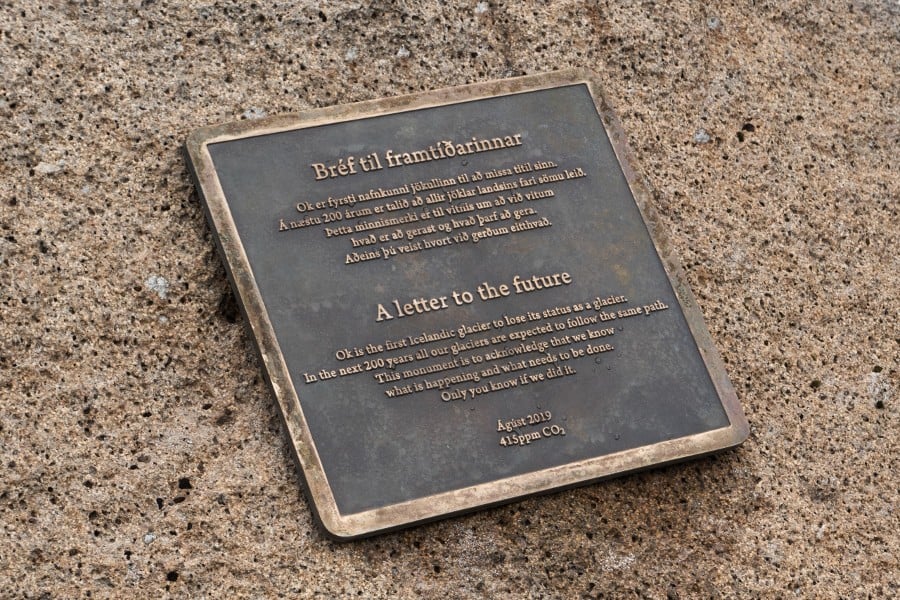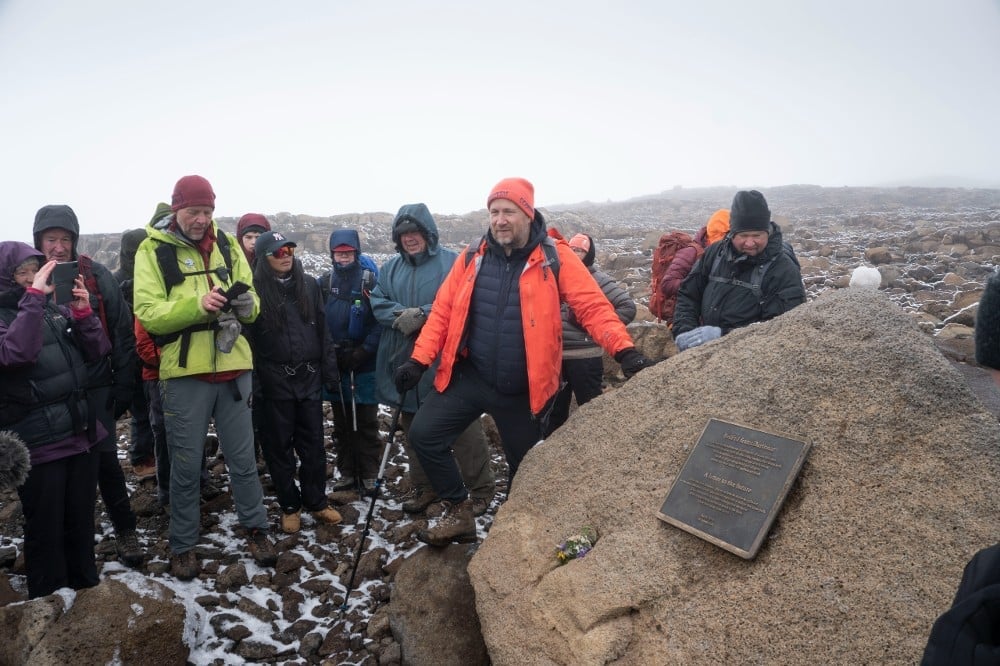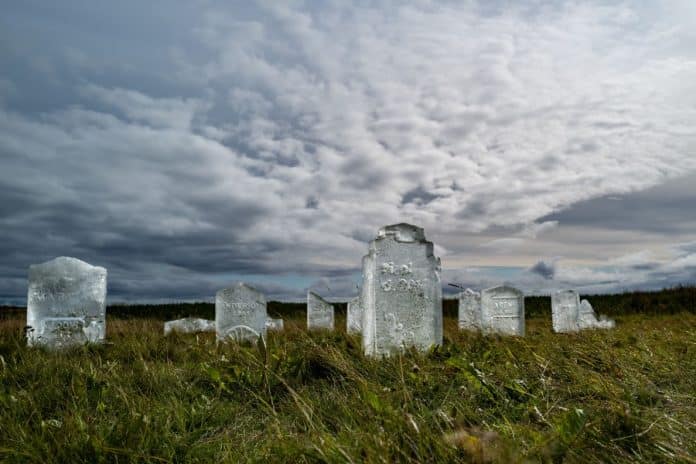Iceland´s glaciers are retreating at such a speed so rapidly that future generations may wonder how Iceland got its name. For this reason Iceland was a logical venue for the World’s first global glacier graveyard, which was unveiled at a ceremony 17 August close to the capital Reykjavik. Researchers from Rice University in Houston, Texas, the Icelandic Met Office, geologists and glaciologists and government leaders attended the ceremony ahead of the International Year of Glaciers´ Preservation in 2025.
On the same occasion The Global Glacier Casualty list of 15 extinct and endangered glaciers was unveiled. According to scientists global warming has led to the disappearance of thousands of glaciers around the world since the year 2000. It is expected that at least half of these glaciers will be lost by 2100.
15 headstones of ice
The glacier graveyard is made of 15 headstones carved from ice by Icelandic ice sculptor Ottó Magnússon.
“We have never needed a graveyard for glaciers before,” Rice University´s Cymene Howe said. “Now we do. And while these headstones will melt away – like their glacial counterparts – we hope the ceremony and icy gravestones serve as poignant reminders that the world’s glaciers are doomed to the same fate without quick action.”
The headstones were placed in a field next to the sea in the Seltjarnarnes peninsula adjacent to the capital Reykjavík, with a splendid view of the Snæfellsjökull across the Faxaflói-bay. The Snæfellsjökull-glacier is well-known to students of world literature as it was the entrance to the center of the earth in Jules Verne´s novel, Journey to the Center of the Earth.
Although the Snæfellsjökull glacier has lost more than half of its size since the end of the 19th century, there are many glaciers that are worse off. Among entries to the Global Glacier Casualty list are the Pizol Glacier, Switzerland (2019), the Sarenne Glacier, France (2023), the Anderson Glacier, USA (2015) and the Martial Sur Glacier, Argentina (2018).

Many will follow
Five years ago the death of the Ok glacier in Iceland was commemorated in a ceremony attended by then Prime Minister of Iceland Katrín Jakobsdóttir and former President of Ireland Mary Robinson. “Since that glacier has its plaque and fame we opted for another Icelandic glacier for the first entry to the list,” one of the organisers, Hrafnhildur Hannesdóttir glaciologist at the Icelandic Met Office, told the UNRIC website. „It is likely that many others will follow, since there are no indications that emissions of CO2 are diminishing.”
As a matter of fact Iceland has already lost 70 of its 400 glaciers. Some of them like the next candidate for extinction, Hofsjökull East, are indeed very small. “It is relatively low lying and flat and will not survive for long,” says Hannesdóttir.
Melting would mean 1 centimetre rise of sea levels
If all Icelandic glaciers would disappear the meltwater would contribute a 1 centimetre rise of sea levels in the world, almost as much as all the glaciers in the Himalayas, according to Icelandic glaciologist Thorsteinn Thorsteinsson in an interview with the UNRIC website. The glaciers in the Himalayas cover around 40,000 km2 but Iceland´s and indeed Europe´s largest glacier, Vatnajökull, covers 7,700 km2. For various reasons “the big one” is expected to survive for perhaps 3 centuries. The second largest glacier in Icleand, Langjökull, is, on the other hand, in more peril not least because it lies much lower. It is predicted that only 10-20% of it will be left in 2100.
Water Tower of Asia
The melting of the glaciers in the Himalayas attracts much more attention than the fate of the Icelandic ones, for understandable reasons. The glaciarized mountains of the Hindu-Kush-Himalaya region have been called the “Water Tower of Asia” since some of the Earth´s most important rivers such as Indus, Ganges, Brahmaputra and Yangtze have their origins there, in a relatively small area. They are considered “a lifeline for hundreds of millions if not billions of people” in the words of Thorsteinsson. They have already lost 40% of their volume since the end of the 19th century. It is predicted that 75% will be lost by the end of this century.
“But their melting does not mean that 2-3 billion people in China and India will die of thirst. The Ganges for instance has its origins in a small glacier, the Gangotri. Rain and snow will continue to fall and groundwater and the Monsoon feed into all of these great rivers,” Thorsteinsson says.
His colleague Hrafnhildur Hannesdóttir points out that the melting has caused increased risk of floods and mudslides, with a frequent and high death toll. “One has to look at the big picture, not focus on only one thing at a time, and we should not forget the sea level rise which will impact even more people.”

Part of the identity
In addition there is a cultural dimension. “These are all glaciers wrapped up in our lives,” Rice University´s Dominic Boyer said. “They belong to the time that we have together, not abstract future losses, but real losses that you can feel and will feel with all of your senses.”
Indeed, the glaciers are also a part of Iceland´s identity. The national flag features a red cross outlined in white with a blue body. The cross stands of course for Christanity, the red for the fire of the volcanos, the blue for the sky and the sea, and the white for ice and snow.
The silver lining is that the white might not disappear even if the glaciers do. The magnificent Snæfellsjökull may lose its status as a glacier, but its white cap might remain. “As a matter of fact the glacier ice on the mountain is relatively thin and its colour is greyish and not very pretty,” explains Thorsteinsson. “But it will not stop snowing, and indeed it is the snow cap that we most admire from afar and all photographers love.”

Internationald year and day of glaciers
The UN General Assembly has declared 2025 the International Year of Glaciers’ Preservation and proclaimed 21 March of each year the World Day for Glaciers. UNESCO, the United Nations Educational, Scientific and Cultural Organization and WMO, the World Meteorological Organization, who are the UN entities in charge of the international year and day, were among the many co-organizers of the event in Iceland.

